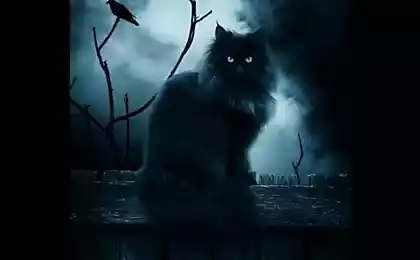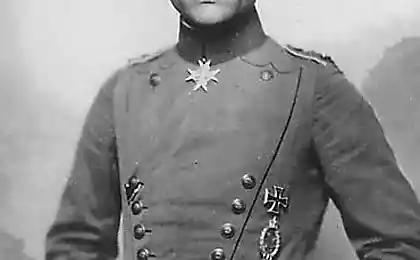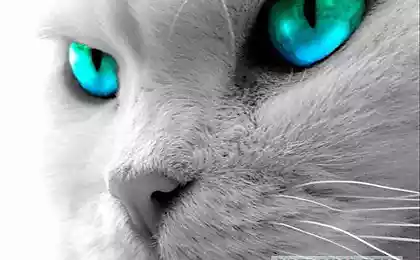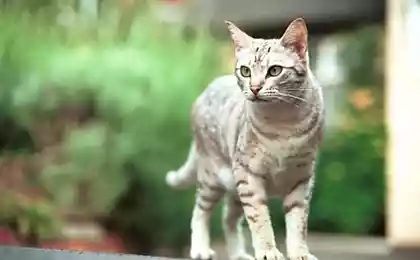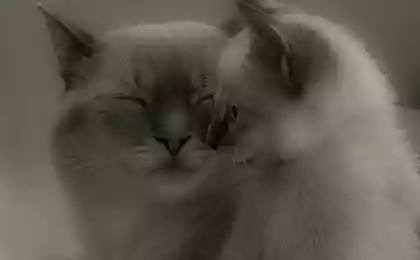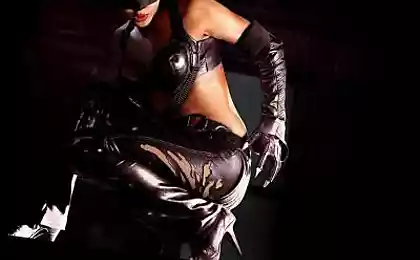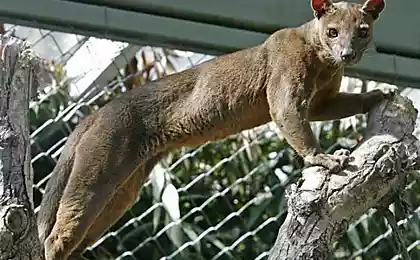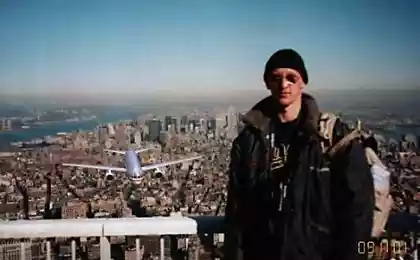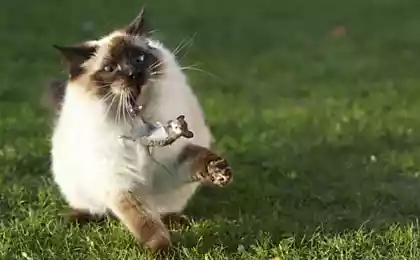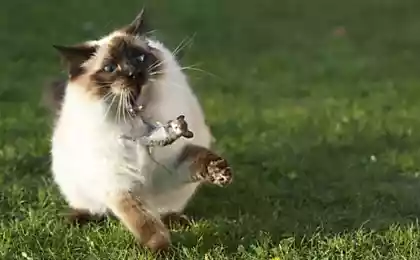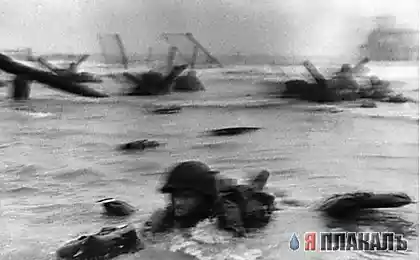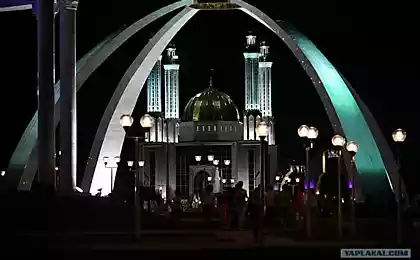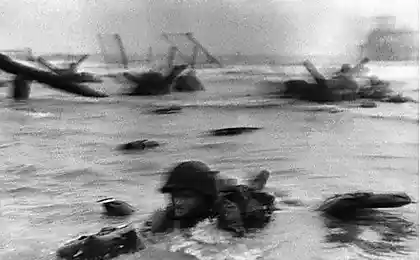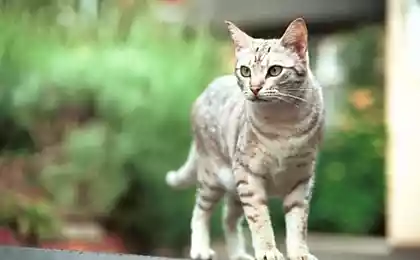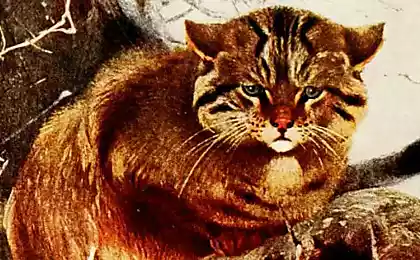1145
Madagascar cat Voss (21 photos)
Of the 10 wild animals in Madagascar three - small civet and, of course, a cat and dog - brought by man. The rest of the seven forms three distinct subfamilies viverrids -fanaluki, ringtailed Mungo and Foss. But Foss only representative of their subfamily

Immediately I warn you about one small zoological "trap": if you find a name Fossa fossana, then please note - this is not the Fossa (whose Latin name Cryptoprocta ferox), and one of the types of fanaluk. Their 1896 Grey confused scientist.
By the way, is not the only systematic lapse with Foss. It is now "one hundred percent" defined as civet, long considered separate representative of the cat (as such, it appears, for example, from Bram). Indeed, the largest in Madagascar and one of the world's largest civet resembles a young cougar appearance, size and gait, and claws - retractable, long, sharp, dental formula resembles that of a feline, even washes her as a domestic cat - lifting his front paws and carefully licking convex pad, and then cleaning out his hind legs, then Being accepted by the tail, and in five or six minutes of removing the rest of the dirt.
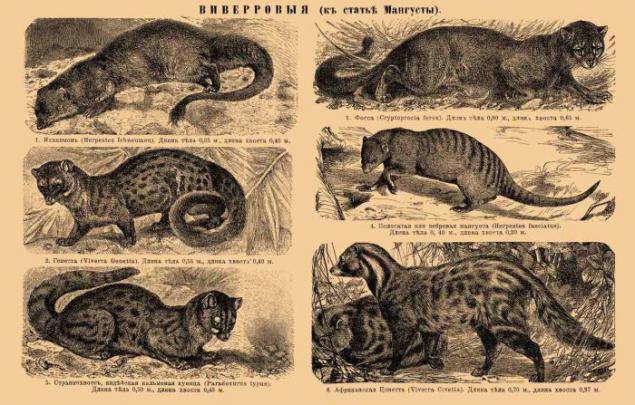
On the island of Madagascar have survived such animals that are not not only in Africa but throughout the rest of the world. One of the rarest animals is Voss (lat. Cryptoprocta ferox) - the only member of the genus Cryptoprocta and the largest carnivorous mammal that lives on the island of Madagascar.
Exterior Foss little unusual: it is a cross between a puma and a small civets. Sometimes called Foss and Madagascan lion, as the ancestors of this animal were much larger and reached the size of a lion. Voss has a squat, massive and slightly elongated body, the length of which can reach up to 80 cm (at an average of 65-70 cm). Paws at Foss long, but thick enough, the hind legs higher than the front. The tail is often equal to the length of the body and reaches up to 65 cm.

The body of the animal is covered with a thick short hair, and on her head she was red in color and on the back - the darker (rust-brown). The animal moves, stepping across the paw, like a bear. Like all members of civet family, Voss has anal glands that secrete a secret with a strong odor. Among the locals are of the opinion that the alleged Foss kill their victims alone disgusting smell of the anal glands.

These animals live mostly on the ground, but often climb trees, where the hunt lemurs - a favorite food Foss. Foss kills its prey by biting of the neck, while tenaciously holding the front paws. This animal feeds not only on small mammals, but also birds, reptiles and even insects. Voss hunt mostly at night and during the day hiding in the den in a cave or in the forks of trees. Animal deftly jumping from branch to branch, and climb trees with the help of not only the legs, but the long tail. Like the exterior, the voice is similar to Voss aggressive feline purr and Young produce sounds very similar to the purring

Foss led solitary life, but during mating, that is in September and October, the female is surrounded by 3-4 males. During the marriage period animals lose their inherent caution and can become very aggressive. Pregnant females lasts 3 months, and the young are usually born in December and January. If other members of the civet family, living on the island of Madagascar, only one calf is born, it is a female Voss - from two to four cubs.
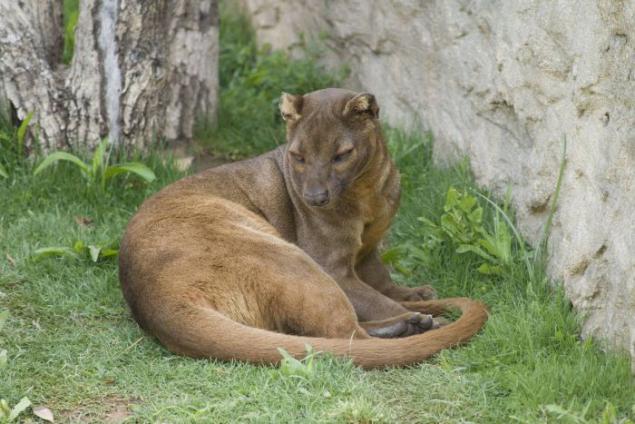
Newborns weigh about 100 grams, they are blind, helpless and covered with fur from light gray hair. Cubs Foss receive their sight at 12-14 days, about 40 days for the first time on their own out of the hole, and two months already climb the branches. Kid involved only females; they feed their young with milk up to 4 months, even though this young age already eat meat. Fossa only 4 years of becoming mature individuals, but leave their burrows at the age of 20 months.
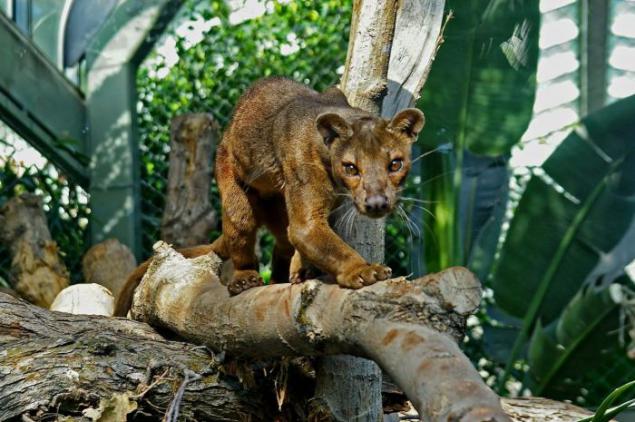
Life expectancy of this animal in captivity is 15-20 years. The number of declining Foss, and blame most people, because of the very large predator of Madagascar has no enemies in nature. Among natives Fossey earned a reputation as a predator, attacking and ruining not only the chicken coops, and killing goats and pigs, and sometimes people. Locals claim that the Fossa, decimating livestock and sometimes destroys more than eating. People hunt for these animals and use their meat for food.
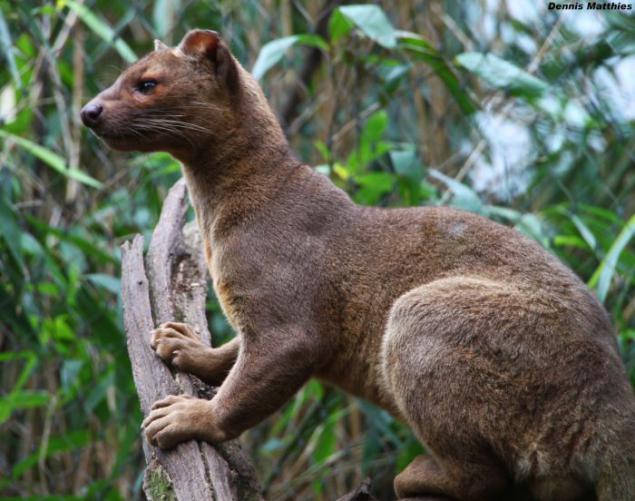
Fosse listed in the Red Book of the International Council for the Conservation of Nature and Natural Resources, as they are on the verge of extinction. Today in the world there are only about 2500 individuals on the basis of which in 2000 received the status of Foss' endangered species ».
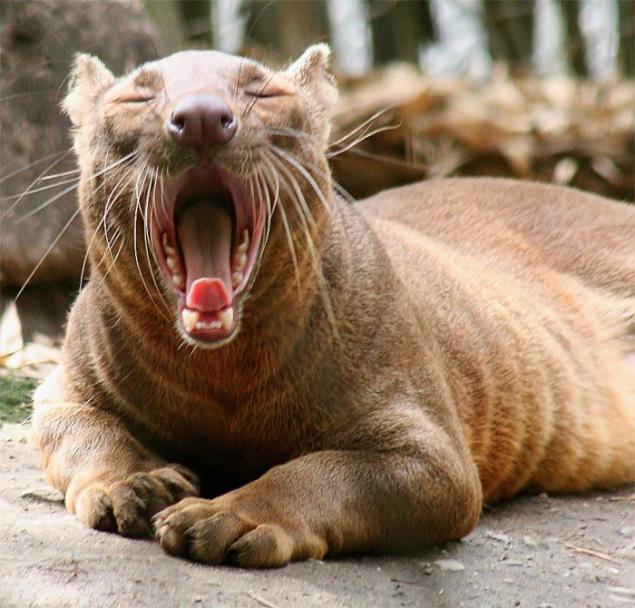
Fossey, apparently alone, although their social behavior has hardly been studied. However, the heat time (September-November) is going around one female fan at 3-4. In the mating season Foss lose usual caution and become even agressivnymi.Pervy intercourse lasts up to an hour. Cubs appear in the November-January, and, unlike other civet Madagascar (how often repeated this phrase!), A female can give birth to 2-4 Foss (and its cousins - just one). The newborn weighs about 100g, is not able to walk, the blind, covered with a thick pale gray, almost white hair. Apparently, the female raises the children alone. After birth, they are always in the shelter or nest. After 15 days, the kids receive their sight, and a month later begin to move and play. Foss has a two-month climb branches and jump on the ground, and three and a half are able to jump from branch to branch, or at 3, 5 meters along the ground. The mother feeds them with milk until the age of 4-4, 5 months, though this time they are starting to eat meat. For two years the animals reach a length of adults, and about then leave mother. For three years the animal finally matures: reaches adult weight and puberty. Lifespan Foss - about seventeen years.
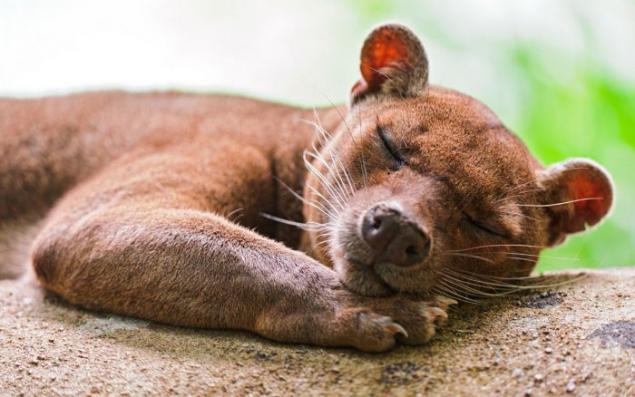
Foss - poludrevesnye animals can even jump from branch to branch and climb the trunks up to 80 cm (though, to overcome a 50 m long section of Voss prefers solid ground). Apparently, this explains that the best option of hiding they believe fork of a tree, though there are holes dug Fosse occupied their caves and even slightly transformed with termite mounds: uh-uh fossyatami. Climb trees Fossa using paws and strong tail is used for maintaining balance and helps with the descent of the vertical shaft. Fosse moves the trunk, front legs wide apart and pulling back under the belly, which are then straightened, and promote animal forward. During the descent the opposite: apart hind legs act as brakes and front podgibayutsya. According to Foss thin vines climb relying on three points, exposing the front forward, the hind paw.
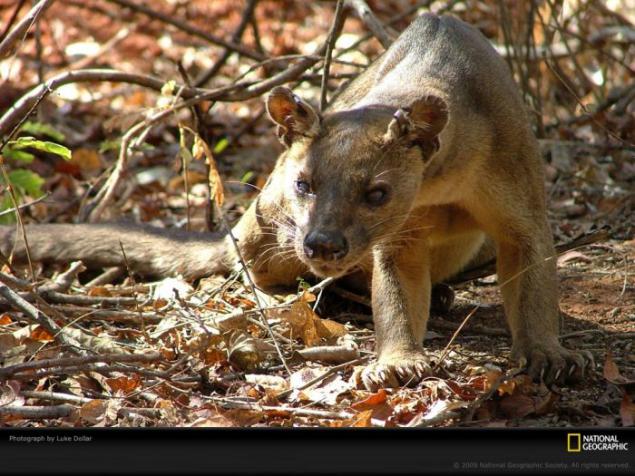
Foss common in Madagascar up to 2000 m. Above sea level, with the exception of the central mountain plateau. It inhabits mountainous forest areas, fields and savannas, and tropical dry deciduous forests, bushes. Voss is secretive, mostly arboreal and nocturnal lifestyle. Depending on the availability of production and the time of year Foss can be active, and during daylight hours. The day is usually spent in various shelters: caves and other natural and of artificial cavities, abandoned termite mounds, or simply in the fork of a tree. It is perfect for climbing and jumping in the trees, where the hunt for their prey. Fosse moves up the trunk, front legs wide apart and pulling back under him, who straightened, pushing it up. During the descent - spaced hind legs act as brakes and front podgibayutsya. Foss swim.
Voss quite ferocious carnivorous predator. Her vision, hearing and smell are well developed. The basis of the diet Foss compose a variety of vertebrates: are birds, amphibians, reptiles and small mammals: tenrecs and lemurs, who account for up to 50% of the total diet. Voss hunt singly or in family groups (female and her young offspring). His prey these predators kills while holding the front paws and biting of the neck. Do not disdain Foss and insects. At night Fassa attacks on other animals, including domestic pigs, chickens and so on. E., With sometimes kills more victims than she could eat.

Voss has a solitary lifestyle except for the breeding season. Her voice reminds cat - Foss publish menacing purr, purr young and males in the mating season shout loudly. During mating Foss meet groups of up to 4-8 individuals, and at this time lose the usual caution and are at this time very aggressive. Both males and females are territorial Foss, and the size of the individual section is approximately 1 km2, the boundaries of which it is aiming secret anal glands. Aggressive behavior is observed only in the breeding season.
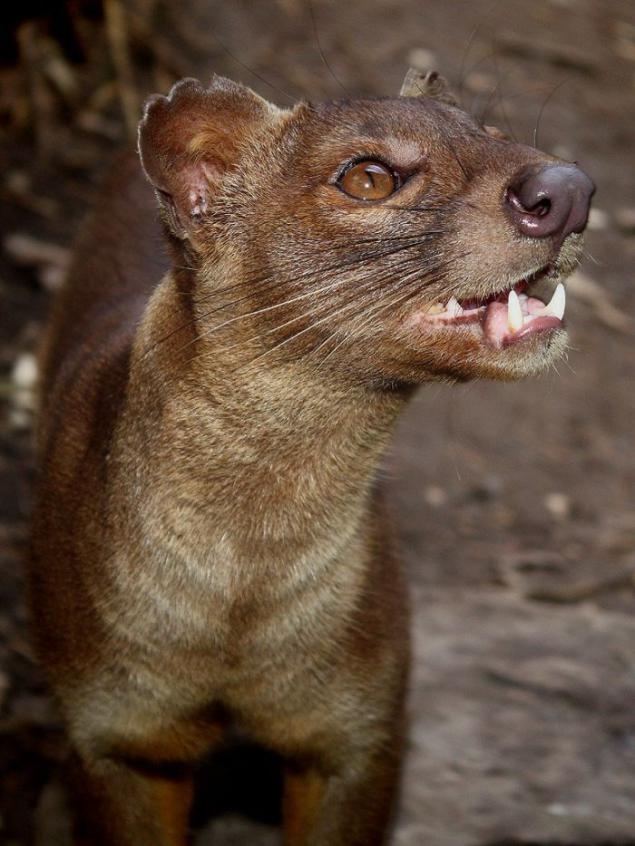
In young animals can attack Foss large snakes and birds of prey. Occasionally Foss victims of crocodiles. Life expectancy in captivity Foss - up to 20 years in captivity correspondingly less.
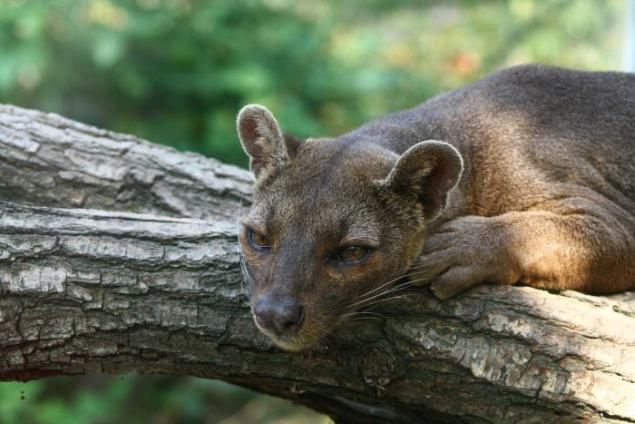
Among the local population is still widespread stories that sometimes Voss hunt large prey, including cattle and humans. But, most of all, it is about an extinct giant Fosse (Cryptoprocta spelea), which in appearance was similar to ordinary Foss, but had a size ocelot. It is assumed that the giant Fossa hunting of large lemurs, and was destroyed by the people who settled on the island. Currently Foss sometimes hurts the person attacking poultry and pigs. It is listed as endangered by IUCN as a species endangered in the Convention CITES (Appendix II). Experts estimate the expected number of Foss in the nature of about 2,500 adults. The main threats to mind - habitat loss and fragmentation of habitat, as well as their direct destruction of local farmers who consider them pests. However, now the program works successfully breeding in captivity Foss.
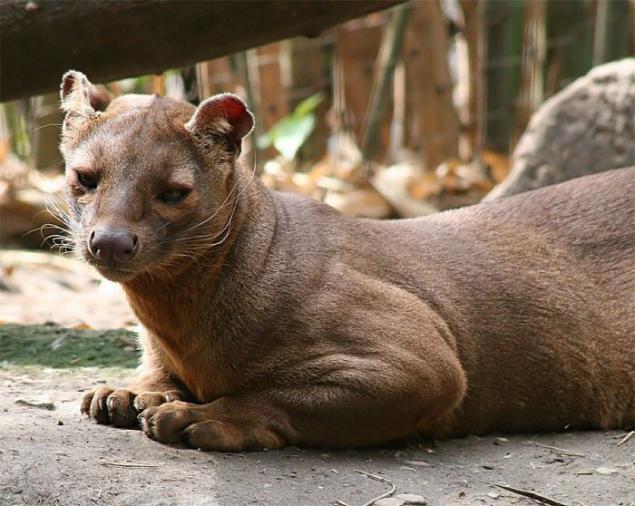
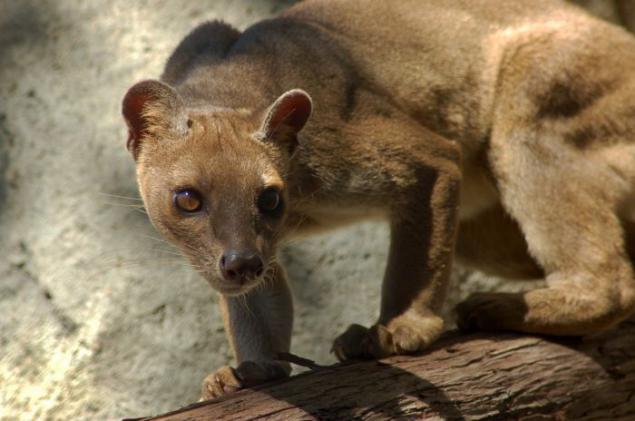

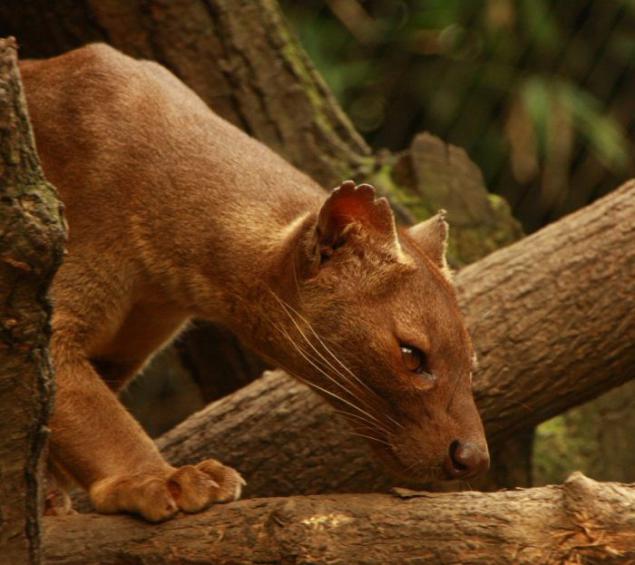
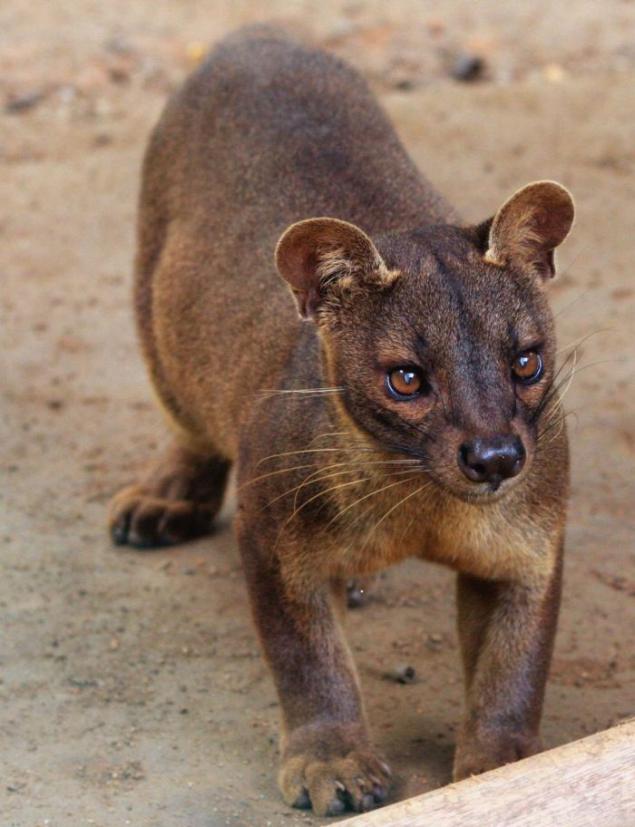

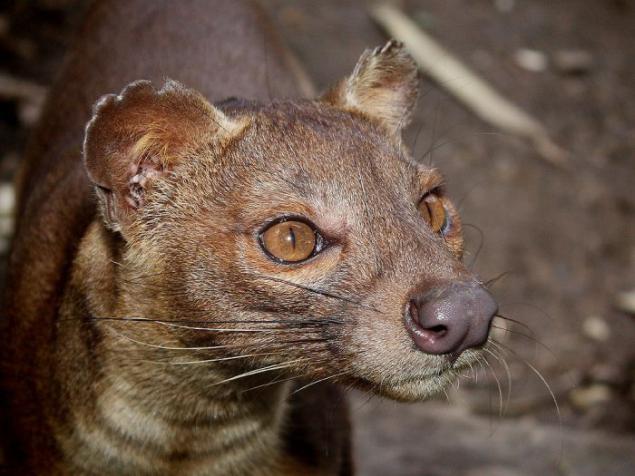

Immediately I warn you about one small zoological "trap": if you find a name Fossa fossana, then please note - this is not the Fossa (whose Latin name Cryptoprocta ferox), and one of the types of fanaluk. Their 1896 Grey confused scientist.
By the way, is not the only systematic lapse with Foss. It is now "one hundred percent" defined as civet, long considered separate representative of the cat (as such, it appears, for example, from Bram). Indeed, the largest in Madagascar and one of the world's largest civet resembles a young cougar appearance, size and gait, and claws - retractable, long, sharp, dental formula resembles that of a feline, even washes her as a domestic cat - lifting his front paws and carefully licking convex pad, and then cleaning out his hind legs, then Being accepted by the tail, and in five or six minutes of removing the rest of the dirt.

On the island of Madagascar have survived such animals that are not not only in Africa but throughout the rest of the world. One of the rarest animals is Voss (lat. Cryptoprocta ferox) - the only member of the genus Cryptoprocta and the largest carnivorous mammal that lives on the island of Madagascar.
Exterior Foss little unusual: it is a cross between a puma and a small civets. Sometimes called Foss and Madagascan lion, as the ancestors of this animal were much larger and reached the size of a lion. Voss has a squat, massive and slightly elongated body, the length of which can reach up to 80 cm (at an average of 65-70 cm). Paws at Foss long, but thick enough, the hind legs higher than the front. The tail is often equal to the length of the body and reaches up to 65 cm.

The body of the animal is covered with a thick short hair, and on her head she was red in color and on the back - the darker (rust-brown). The animal moves, stepping across the paw, like a bear. Like all members of civet family, Voss has anal glands that secrete a secret with a strong odor. Among the locals are of the opinion that the alleged Foss kill their victims alone disgusting smell of the anal glands.

These animals live mostly on the ground, but often climb trees, where the hunt lemurs - a favorite food Foss. Foss kills its prey by biting of the neck, while tenaciously holding the front paws. This animal feeds not only on small mammals, but also birds, reptiles and even insects. Voss hunt mostly at night and during the day hiding in the den in a cave or in the forks of trees. Animal deftly jumping from branch to branch, and climb trees with the help of not only the legs, but the long tail. Like the exterior, the voice is similar to Voss aggressive feline purr and Young produce sounds very similar to the purring

Foss led solitary life, but during mating, that is in September and October, the female is surrounded by 3-4 males. During the marriage period animals lose their inherent caution and can become very aggressive. Pregnant females lasts 3 months, and the young are usually born in December and January. If other members of the civet family, living on the island of Madagascar, only one calf is born, it is a female Voss - from two to four cubs.

Newborns weigh about 100 grams, they are blind, helpless and covered with fur from light gray hair. Cubs Foss receive their sight at 12-14 days, about 40 days for the first time on their own out of the hole, and two months already climb the branches. Kid involved only females; they feed their young with milk up to 4 months, even though this young age already eat meat. Fossa only 4 years of becoming mature individuals, but leave their burrows at the age of 20 months.

Life expectancy of this animal in captivity is 15-20 years. The number of declining Foss, and blame most people, because of the very large predator of Madagascar has no enemies in nature. Among natives Fossey earned a reputation as a predator, attacking and ruining not only the chicken coops, and killing goats and pigs, and sometimes people. Locals claim that the Fossa, decimating livestock and sometimes destroys more than eating. People hunt for these animals and use their meat for food.

Fosse listed in the Red Book of the International Council for the Conservation of Nature and Natural Resources, as they are on the verge of extinction. Today in the world there are only about 2500 individuals on the basis of which in 2000 received the status of Foss' endangered species ».

Fossey, apparently alone, although their social behavior has hardly been studied. However, the heat time (September-November) is going around one female fan at 3-4. In the mating season Foss lose usual caution and become even agressivnymi.Pervy intercourse lasts up to an hour. Cubs appear in the November-January, and, unlike other civet Madagascar (how often repeated this phrase!), A female can give birth to 2-4 Foss (and its cousins - just one). The newborn weighs about 100g, is not able to walk, the blind, covered with a thick pale gray, almost white hair. Apparently, the female raises the children alone. After birth, they are always in the shelter or nest. After 15 days, the kids receive their sight, and a month later begin to move and play. Foss has a two-month climb branches and jump on the ground, and three and a half are able to jump from branch to branch, or at 3, 5 meters along the ground. The mother feeds them with milk until the age of 4-4, 5 months, though this time they are starting to eat meat. For two years the animals reach a length of adults, and about then leave mother. For three years the animal finally matures: reaches adult weight and puberty. Lifespan Foss - about seventeen years.

Foss - poludrevesnye animals can even jump from branch to branch and climb the trunks up to 80 cm (though, to overcome a 50 m long section of Voss prefers solid ground). Apparently, this explains that the best option of hiding they believe fork of a tree, though there are holes dug Fosse occupied their caves and even slightly transformed with termite mounds: uh-uh fossyatami. Climb trees Fossa using paws and strong tail is used for maintaining balance and helps with the descent of the vertical shaft. Fosse moves the trunk, front legs wide apart and pulling back under the belly, which are then straightened, and promote animal forward. During the descent the opposite: apart hind legs act as brakes and front podgibayutsya. According to Foss thin vines climb relying on three points, exposing the front forward, the hind paw.

Foss common in Madagascar up to 2000 m. Above sea level, with the exception of the central mountain plateau. It inhabits mountainous forest areas, fields and savannas, and tropical dry deciduous forests, bushes. Voss is secretive, mostly arboreal and nocturnal lifestyle. Depending on the availability of production and the time of year Foss can be active, and during daylight hours. The day is usually spent in various shelters: caves and other natural and of artificial cavities, abandoned termite mounds, or simply in the fork of a tree. It is perfect for climbing and jumping in the trees, where the hunt for their prey. Fosse moves up the trunk, front legs wide apart and pulling back under him, who straightened, pushing it up. During the descent - spaced hind legs act as brakes and front podgibayutsya. Foss swim.
Voss quite ferocious carnivorous predator. Her vision, hearing and smell are well developed. The basis of the diet Foss compose a variety of vertebrates: are birds, amphibians, reptiles and small mammals: tenrecs and lemurs, who account for up to 50% of the total diet. Voss hunt singly or in family groups (female and her young offspring). His prey these predators kills while holding the front paws and biting of the neck. Do not disdain Foss and insects. At night Fassa attacks on other animals, including domestic pigs, chickens and so on. E., With sometimes kills more victims than she could eat.

Voss has a solitary lifestyle except for the breeding season. Her voice reminds cat - Foss publish menacing purr, purr young and males in the mating season shout loudly. During mating Foss meet groups of up to 4-8 individuals, and at this time lose the usual caution and are at this time very aggressive. Both males and females are territorial Foss, and the size of the individual section is approximately 1 km2, the boundaries of which it is aiming secret anal glands. Aggressive behavior is observed only in the breeding season.

In young animals can attack Foss large snakes and birds of prey. Occasionally Foss victims of crocodiles. Life expectancy in captivity Foss - up to 20 years in captivity correspondingly less.

Among the local population is still widespread stories that sometimes Voss hunt large prey, including cattle and humans. But, most of all, it is about an extinct giant Fosse (Cryptoprocta spelea), which in appearance was similar to ordinary Foss, but had a size ocelot. It is assumed that the giant Fossa hunting of large lemurs, and was destroyed by the people who settled on the island. Currently Foss sometimes hurts the person attacking poultry and pigs. It is listed as endangered by IUCN as a species endangered in the Convention CITES (Appendix II). Experts estimate the expected number of Foss in the nature of about 2,500 adults. The main threats to mind - habitat loss and fragmentation of habitat, as well as their direct destruction of local farmers who consider them pests. However, now the program works successfully breeding in captivity Foss.







